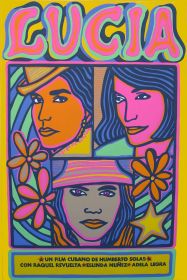
1968, Raul Martinez
Lucia
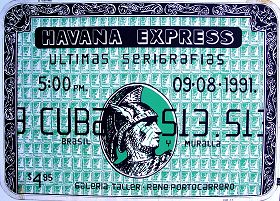
1991, Eduardo Marin
Havana Express
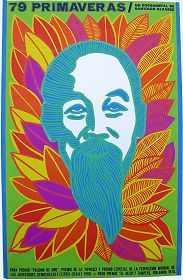
1970, Antonio Reboiro
79 Primaveras
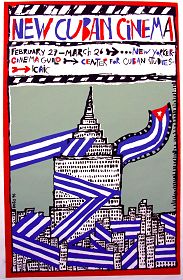
1985, Eduardo Munoz Bachs
New Cuban Cinema
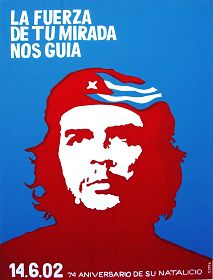
2002, Suitberto Goire
La Fuerza de tu mirada nos guia
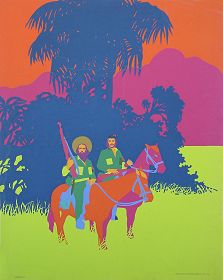
1971, Rene Mederos
Untitled (Che and Camillo on horseback)
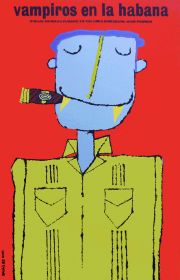
1985, Eduardo Munoz Bachs
Vampiros en La Habana
LA CUBANIDAD! is an exhibition which gives, for the first time ever in Austria, a survey of sixty years of Cuban poster art, exploring that title-giving phenomenon of national identity that has come to be known as "Cubanidad" and, with almost natural ease, derives synergies from apparent antagonisms: Santeria and Catholic orthodoxy, Chevrolet and anti-Americanism, La Guantanamera and Guantanamo, slave trade and colonialization. In this melting pot of Indian, Spanish, African and Latin-American influences, a unique art amalgamated with a plurality of styles which particularly manifests in poster art.
Under the pre-revolutionary Batista regime, the poster was given little scope to contribute to national Cuban identity formation. Cuba was the Latin-American test market of the international film industry. Poster designs followed international styles and were printed abroad. After the revolution, it was not only poster designs which changed, but also their reception: "The `selling' interest was replaced by a `persuading' interest, and the recipients of messages were no longer male and female consumers, but men and women of the people, citizens, irrespective of their social position or purchasing power," says Jose (Pepe) Alberto Menendez, graphic artist and currently Art Director of the Casa de las Americas in Havana.
Financial necessity made an artistic virtue: posters were produced by labor- intensive silk-screen printing. Strong contrasts, glaring colors, and symbol- charged messages brought a bloom to post-revolutionary Cuban poster art which was to last until the mid-1970s.
There are three publishing houses that have been considered as centers of poster art ever since the revolution: the Cuban Film Institute, ICAIC (Instituto Cubano del Arte y la Industria Cinematograficos), the Solidarity Organization of the Peoples of Africa, Asia, and Latin America, OSPAAAL (Organizacion de Solidaridad con los Pueblos de Asia, África y America Latina), and the Communist Party Press, EP (Editora Politica). One name that is inseparably linked with ICAIC film poster designs is Muñoz Bach: his oeuvre comprises some two thousand designs and is distinguished by a tinge of irony. What becomes evident in his work is the influence of Polish poster art with its surreal figuration and painterly calligraphy. Raul Martinez, by contrast, echoes pop-art style in his poster for a movie entitled "Lucia" (1968).
OSPAAAL posters are distributed a supplements of the political "Tricontinental" magazine. Its main subjects are wars in so-called Third-World countries which are covered in sparse text and easily understood imagery. The leading graphic artists of this school are, above all, Alfredo Rostgaard and Olivio Martinez Viera. In 1969, for example, Rostgaard designed a poster in remembrance of the violent death of the Columbian militant Christian and guerrilla priest Camilo Torres (Jorge Camilo Torres Restrepo), which visibly adheres to the tradition of icon painting.
Cuban political posters are plain and easily comprehensible. The utopian optimism of the revolution era is expressed in emotive affiches that reveled in the leader cult of Ernesto Che Guevara and Fidel Castro. It was through posters that Che's well-known portrait after a photograph by Alberto Korda became a global symbol of romanticized rebellion.
From the 1980s, Cuban posters unjustly met with less attention. Poster production in fact decreased dramatically, not least because of the continuing U.S. embargo. Nevertheless, graphic artists such as Elio Rodriguez Valdes, Eduardo Marin, Manuel Marzel, Pepe Menendez, or Suitberto Goire went on creating convincing designs, sometimes by humorous adaptation of familiar subjects. 1991, for example, Eduardo Marin's "Havanna Express" poster stirred much excitement because the artist had blown up an "American Express" card to poster size to advertise an exhibition; an public affront at a time when the dollar still was forbidden currency in Cuba.
The show at the MAK Works on Paper Room, originally compiled by Beverly Walton for Track 16 Gallery in Santa Barbara, is a graphic review of life in Cuba in terms of posters. Photographs and artists' statements help to place the posters in the context of their period of origin. Lenders for the exhibition are Global Graphics (Los Angeles), the Center for the Study of Political Graphics (Los Angeles) as well as The Cuban Art Space, and the Center for Cuban Studies (New York).
With this exhibition, the MAK continues a series of activities that deal with art and architecture in Havana. In 1992 already, the MAK presented a historical exhibition in Havana (New World View and Self-Glorification. Nueva imagen del mundo y autoglorificacion).
In a MAK-initiated conference in Havana entitled The Havana Project Architecture Again (1994), contemporary architectural interventions for urban problem zones were developed and discussed on site in the historic old city of Havana. The results of this conference, in which a number of seminal international architects participated, such as Eric Owen Moss, C.P.P.N., Thom Mayne, Carme Pinos, Lebbeus Woods, and Coop Himmelb(l)au, were compiled with comprehensive descriptions and architectural models for a traveling exhibition which after being shown at the MAK Center, Los Angeles, (1996), in Hannover, Germany (1997), and at the MAK Vienna (1998) returned to its place of origin, the Centro Nacional de Conversacion, Restauracion y Museologia (CENCREM) in Havana's Convent of Santa Clara in fall 1999.
Moreover, an exhibition of contemporary Cuban architecture entitled Manifestos. Exposicion International de Arquitetura Contemporanea was shown at the CENCREM in 1995. The MAK Center for Art and Architecture, Los Angeles, initiated a traveling exhibition about Architecture and Revolution. Escuelas Nacionales de Arte en La Habana, which paid a tribute, with a show of photographs, plans and blueprints, to the once-famous National Art Schools of Havana which are today abandoned and exposed to dilapidation. LA CUBANIDAD! now addresses another aspect of Cuban identity.